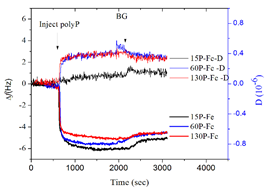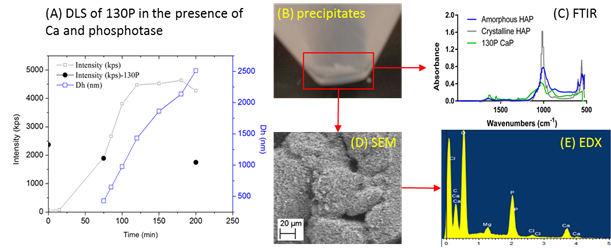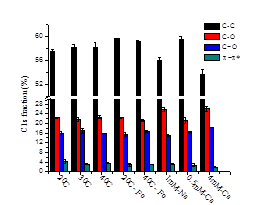Reports: DNI554143-DNI5: Assessing the Wettability Alteration of Carbonate Minerals at Nano-Scale
Yuanzhi Tang, Georgia Institute of Technology
The main goal of this research is to elucidate the molecule to nano scale interactive mechanisms between complex organic/inorganic molecules and mineral surfaces, and the impact of such interactions on the surface charge, structure, and reactivity of minerals at nano scale. So far we have examined the interaction of (1) polyanion (e.g. polyphosphate) and (2) natural organic matter (e.g. humic acid) with several environmental minerals (iron oxide, aluminum oxide, and calcium carbonate).
(1) Polyphosphates are the polymers of at least three phosphate ions joined by phosphoanhydride (P-O-P) bonds. They are a group of phosphorus (P) species that is widely used for many industrial processes, and are also natural molecules that are synthesized by almost all organisms, such as bacteria and planktons in both terrestrial and marine settings. During common cell events, such as extracellular release, lysis, death and burial of microorganisms, polyphosphates are released into water bodies and incorporate into sediments, where they likely undergo a range of transport and transformation processes, such as biotic and abiotic hydrolysis, release of inorganic orthophosphate, as well as the precipitation and formation of phosphate mineral phases. Understanding the fate and transport of polyphosphate in natural and engineered environment is important for determining the impact of polyphosphate-based surfactants. This system is also used as a model system for our study of organic/inorganic polyanion interaction with mineral surfaces and modification of surface reactivities which can occur during various stages of oil reservoir rock diagenesis and oil exploration.
We tested the sorption of polyphosphate with different chain lengths onto common iron and aluminum oxide surfaces under varied pH conditions, electrolytes (e.g. Ca2+, Mg2+), and microbial metabolites (e.g. phosphatase enzyme), using a suite of complementary techniques such as quartz crystal microbalance with dissipation (QCM-D), dynamic light scattering (DLS), atomic force microscopy (AFM), nuclear magnetic resonance (NMR) spectroscopy, scanning electron microscopy (AFM), and Fourier transformed infrared (FTIR) spectroscopy (Figure 1-3). Linear polyphosphates was found to adsorb onto mineral surfaces with the deprotonated side groups instead of the terminal groups via the formation of inner-sphere complexes with high affinity. As pH increases to 10, there was much less adsorption of polyphosphate compared to that at lower pH conditions (4, 6 and 8), due to the electrostatic repulsion between the molecules and the surfaces. There was a difference in the rigidness of the adsorbed polyphosphate layer between different minerals and pH conditions, as demonstrated by the dissipation to frequency ratio. The presence of calcium in the solution significantly enhanced the adsorption of polyphosphate, probably due to the bridging of the polyphosphates by calcium. At high calcium concentrations and in the presence of phosphatase enzyme, calcium phosphate precipitates with amorphous nature was formed, which is likely to modify the surface structure and properties of the parent mineral. Ongoing studies using microcalorimetry and spectroscopy will aid in quantitative measurements of the interaction thermodynamics and characterization of the speciation at the interfaces. We will further study the effects of surface morphology (flat or curved) and surface impurities on the interaction. Results from this systematic investigation at molecular scale will provide insights to the general mechanisms of polyanion interaction with minerals and modification of mineral surface structure and reactivities within natural and engineered systems.
(2) Natural organic matter (NOM) such as humic substances are increasingly recognized as supramolecular associations of small molecules linked by non-covalent bonds such as H-bond, hydrophobic and electrostatic forces. Humic substances are highly heterogeneous in terms of their physicochemical properties in that the constituting small molecules have a broad spectrum of molecular weight and chemical structure, and they associate with each other to form similarly a broad range of supramolecular associates. This intrinsic heterogeneity and the complex effects of solution chemistry on this heterogeneity govern the behavior of humic substances in many important environmental processes, yet the mechanistic understanding of such effects are far from clear. Sorption, NOM adlayer properties (e.g., molecular configuration and distribution) and desorption are three closely related aspects of humic-surface interaction. Yet, few studies have systematically related these three aspects of NOM-mineral interaction. Relatively few studies had looked at the effects of temperature and ionic strength fluctuation on the sorption and especially desorption of NOM, despite the fact that fluctuations in temperature and solution chemistry are very common in the environment due to seasonal and precipitation changes. We studied the sorption, adlayer characteristics, and desorption of humic acid under dynamic temperature and ionic strength conditions on Fe and Al oxide minerals using a suite of complementary techniques, such as QCM-D, AFM, and X-ray photoelectron spectroscopy (XPS) (Figure 4-5). Our preliminary study of humic acid sorption to Fe oxide surface showed that the sorption greatly decreased as temperature increases from 20 to 40 °C, while there is little variation in surface-bound NOM composition and its viscoelastic property. Ionic strength and cation type have more significant effects on NOM configuration in solution, sorption fractionation, and the NOM adlayer characteristics. NOM desorption kinetics and molecular composition of the desorbed NOM are strongly dependent on the magnitude of temperature and ionic strength fluctuation.
Figure 1. QCM-D measurements showing the frequency and dissipation change due to polypP sorption onto iron oxide coated sensors at pH 6 for three types of polyP with varied chain lengths (15, 60, and 130P). | Figure 2. Enzymatic hydrolysis of dissolved polyphosphates with different chain lengths and the production of orthophosphate in the presence of alkaline phosphatase. | |
Figure 3. Hydrolysis of polyP and precipitation of Ca-P mineral(s) in the presence of phosphatase and Ca2+. (A) Real time observation of solid particle formation using DLS, (B) picture of the white precipitates after 24 hr, (C) FTIR spectra of the precipitate, (D) and (E) are SEM and energy dispersive spectra (EDX) showing the morphology and composition of the precipitate. | ||
Figure 4. Δf plot for humic acid sorption onto Al or Fe oxide coated QCM-D sensors under different temperature conditions. | Figure 5. C composition of humic acid sorbed metal oxide surface under different temperature, ionic strength, and electrolyte conditions based on C 1s XPS analysis. | |
















